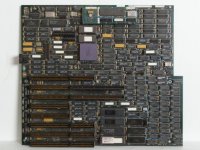vladstamate
Experienced Member
Those are two different questions.
Since a 386 is a superset of the 286, it should be compatible with 286 hardware, not 8088 hardware, if you want to run all software.
Namely, some software will try to auto-detect what system they are running on, and when they detect a 286 or higher, they may make various other assumptions about the hardware as well (all 286-based PC-compatibles are AT-compatible, which is very different from being PC/XT-compatible).
If you just want to run 'some' software, which has no knowledge of any system beyond the original PC/XT, you could cheat a little.
An AT has these things that PC/XT do not have:
- Second 8259A PIT
- Second 8237A DMA controller
- MC146818 CMOS realtime clock/32 kHz timer
- AT keyboard interface
Hey Scali,
Don't you mean second 8259A PIC (and not PIT)? The interrupt controllers are two so you can have more than 8 interrupts (achieved via cascading). But there should still be only one 8253 PIT, correct?
Also I think that on a 386 motherboard (maybe all but early AT compatibles) had some of those chips: 8253, 8259 and/or 8237 condensed in a single chip on board? Makes no difference to programming though.
Regards,
Vlad.

